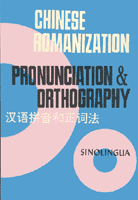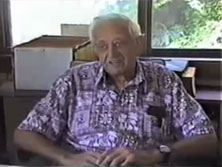 What’s the most commonly used morpheme in Mandarin? It isn’t the word for is (shì/是). And it’s not the one for not (bù/不). And the number one (yī/一) is only number two — in frequency, that is. (Even some of that is that Hanzi frequency counts include 一 used as a dash.) Nope, it’s that little grammatical particle de (的).
What’s the most commonly used morpheme in Mandarin? It isn’t the word for is (shì/是). And it’s not the one for not (bù/不). And the number one (yī/一) is only number two — in frequency, that is. (Even some of that is that Hanzi frequency counts include 一 used as a dash.) Nope, it’s that little grammatical particle de (的).
Today’s selection from Chinese Romanization: Pronunciation and Orthography is all about de (800 KB PDF).
So, whaddaya do with de in Pinyin? Simple: It’s almost always written separately from the words around it.
- māma de ài (mother’s love)
- zhàopiàn de bèimiàn (back of a photograph)
- lìshǐ de jīngyàn (the experience of history)
- dàmén wài de shíshīzi (the stone lions outside the gate)
- nǐ de yǔsǎn (your umbrella)
- zhèyàng de rén (people of that sort)
- tā zìjǐ de cuòwu (his own mistake)
- jìlái de xìn (the letter that was sent)
- chī chóngzi de zhíwù (insectivorous plants)
- Chī de, chuān de, yòng de, yàngyàng dōu yǒu. (They have all kinds of food, clothing, and other items of use.)
- hǎo de bànfǎ (a good solution)
- wǒ xǐhuān de xiézi (the shoes I like)
So, yeah, that means if you want to write down a common Mandarin obscenity, it’s tāmā de (他媽的), not tāmāde — though I wouldn’t be surprised if that becomes treated as one word over time.
There are just a few exceptions. This particular de is written together with the component it follows only in the following cases:
- yǒude 有的 (some): Yǒude rén tànxi, yǒude rén liúlèi. (Some people were sighing, while others wept.)
- shìde 是的 (yes, certainly): Shìde, wǒ jiù qù. (Certainly, I’ll go right away.)
- shìde 似的 (like, as): Xiàng hóuzi shìde, tiàolái tiàoqù. (Jumping around, just like a monkey.)
But 的 isn’t Mandarin’s only common de. Let’s not forget de (地, the 20th most commonly used Hanzi) and de (得, 35th).
These three homophonous particles are represented by three different characters in writing; would it perhaps be useful to create three different Hanyu Pinyin forms to differentiate them in Hanyu Pinyin writing? The basic principle of Hanyu Pinyin orthography is to take the language’s sound system as the basis for spelling, and, by this standard the three particles 的, 地, and 得 should all be written identically as “de.” But it may be desirable in certain situations (such as Chinese-language word processing and other computer applications, and in machine translation) to differentiate the three. In this case, they may be assigned different written forms: 的, the most commonly used, as “d”; 地 as “di” (an alternate pronunciation of this character); and the third, 得, as “de.”
That’s:
- 的 = d (pronounced de)
- 地 = di (pronounced de)
- 得 = de (pronounced de)*
(* Yes, I know those all have other readings. But we’re not talking here about Chinese characters with multiple pronunciations.)
But you don’t have to use those orthographic variants if you don’t want to. For an example of a text that does use d and de, see this lovely story: Dàshuǐ Guòhòu (After the Flood).
OK, let’s get back to those other de‘s.
de 地
The principal function of this particle is to link an adverbial modifier to “the verb or adjective it modifies. de 地 is always written separately from the elements preceding and following it.
Thus:
- suíbiàn de kàn (look over casually)
- mànmàn de zǒu (walk slowly)
- yī kǒu yī kǒu de chī (eat bite by bite)
de 得
The principal function of this particle is to link a verb or adjective with its complement. The complement expresses possibility, degree, or result, and may be composed of a single word or a phrase. The verb or adjective preceding de 得 may only be a single word, never a phrase. de 得 is in principle written separately from the elements preceding and following it. The bù 不 that negates a de 得 expressing possibility is also written separately from the elements around it.
Thus,
- hǎo de hěn (very good)
- duō de duō (much more)
- lěng de yàomìng (freezing cold)
- hēi de kànbujiàn rén (so dark one can’t see the people around one)
- gāoxìng de jǐnjǐn wòzhu ta de shǒu shuō: “Xièxie! Xièxie!” (so happy I could only grasp his hand and say, “Thank you! Thank you!)
There are two main situations in which de 得 should be written as one unit with the component that precedes or follows it. Let us take a look at these:
(1) de 得 sometimes joins together with the verb that precedes it to form a single word. Sometimes a bù 不 is interposed between the verb and de 得 to indicate negation. In either case, all elements are written as one unit.
- dǒngde (to understand)
- jìde (to remember)
- jiànde (to seem)
- juéde (to feel)
- láide (to be competent (to do something)
- láibude (impermissable)
- liǎode (terrible)
- liǎobude (teriffic)
(2) In certain trisyllabic verb-complement constructions in which de 得 (or the negative marker bù 不) forms the middle syllable, the meaning of the complement has altered and the whole has come to express a single concept. In this case all three syllables should be written as one unit.
- láidejí (there’s still time; to be in time)
- láibují (there’s no time; to be too late)
- chīdekāi (to be popular)
- chībukāi (be unpopular)
- duìdeqǐ (not let somebody down)
- duìbuqǐ (let somebody down; also, “excuse me”)
- chīdexiāo (be able to bear)
- chībuxiāo (be unable to bear)

